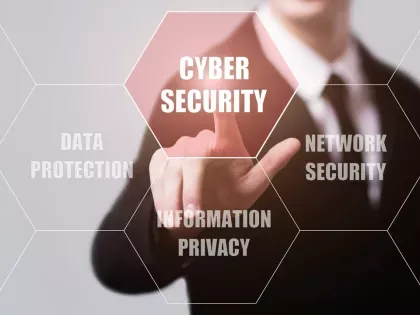Read about the latest cybersecurity news and get advice on third-party vendor risk management, reporting cybersecurity to the Board, managing cyber risks, benchmarking security performance, and more.
Insights blog.

Critical Vulnerabilities Discovered in Automated Tank Gauge Systems
Bitsight TRACE explores several critical vulnerabilities discovered in ATG systems and their inherent risk when exposed to the Internet.

The retail sector has proven that when top minds put their heads together, they can make real headway against pernicious cyber threats. Case in point: the industry-wide adoption of EMV chip cards has played a role in reducing point-of-sale malware attacks by 93% since 2014.

This past Tuesday, Bitsight was named a Leader in The Forrester New Wave™: Cybersecurity Risk Rating Solutions, Q4 2018 evaluation. This report evaluates the current offering and strategy of vendors in a particular technology market, such as security ratings. This is significant, as this is the first analyst report that has a core focus on evaluating security ratings services solutions side-by-side.

Businesses are becoming increasingly reliant on outsourced IT services to support day-to-day operations.

In Spain, cybersecurity is becoming more of a priority among businesses across all industries. One way to quantify these cybersecurity postures is by looking at Spain’s security ratings across all markets. In Spain, Bitsight Security Ratings are on average 119 points below Europe as a whole. The highest performing industry is Real Estate, which has a security rating of 71 security rating points better than the European average. The lowest performing industries are Financial Services and Insurance, which are more than 200 security rating points lower than the average European rating. Given the sensitive data financial services companies possess, this report suggests there is a need for additional investment in cybersecurity and cyber risk management. As companies invest in digital transformation programs, their exposure to risk increases and requires an increased investment in risk management across their organization.

October was Cybersecurity Awareness Month, which gave companies the opportunity to thoroughly examine their security and risk programs and identify where they can strengthen security practices. A Bitsight, we talk about risk management every day. We sat down with our Co-Founder & CTO, Stephen Boyer, to talk about the significance of having a risk-aware organization and proactive ways security ratings can help with risk management.

Banks and other financial institutions are a proving ground for new risk management methods. High risk and intense regulations feed into a culture of serious, comprehensive security — a culture that has manifested in mature methodologies such as the three lines of defense.

Business leaders now realize that their data is being exposed to risk by their vendors, and that monitoring and remediating these threats is a necessary part of an effective cybersecurity program.

Cybersecurity is a growing topic of discussion in Board meetings everywhere — given this fact, Board members need to be prepared to speak knowledgeably about their organization’s cybersecurity posture and programs. As businesses near the last quarter of the year and begin their planning processes, Boards must also be thinking about how to best prepare for 2019. Here are some factors that Boards must take into consideration:

In a 2017 survey of almost 1,300 CEOs conducted by PwC, 63% of respondents said they were “extremely concerned” about cyber threats — up from just 8% in 2013.

In today’s landscape, managing your internal security processes as well as creating a third-party vendor risk management program should be top of mind, but prioritizing a solid understanding of the metrics surrounding your cybersecurity programs almost just as important. These metrics should dive deeper than “yes” or “no” questionnaire answers, but should help you gain a more comprehensive understanding of where you and your third parties fall when it comes to proactively mitigating cyber risk.

Over the last several months, members of our product team have been working to aggregate all of Bitsight’s security ratings data and highlight important insights about patterns in data breaches. In fact, Bitsight boasts one of the largest data breach data sets. Of course, this only highlights what data Bitsight has visibility into; with the largest sinkholing infrastructure in the world and the security posture of over 130,000 organizations, we have the most comprehensive view into global breach trends.

CISOs and other security leaders are tasked with protecting their organizations from cyber attacks. That means developing and implementing the policies, controls, and procedures that reduce risk and ensure the safety of sensitive data. It also means keeping the cybersecurity program alive and well-funded.In other words, security leaders are fighting on two fronts. When executing a cybersecurity plan, they must employ two distinct yet equally important skill sets: the technical skills to mitigate risk, and the strategic skills to make the case for cybersecurity to their colleagues. Striking a balance between these two categories is tricky. We’ve got some tips for CISOs and other security leaders looking to execute their cybersecurity plans effectively and achieve sustainable results.

Cybersecurity is a multifaceted topic with many constantly evolving variables. For CISOs and other security leaders, just knowing where to begin can be a challenge.Let’s say you’ve just taken over an organization’s cybersecurity program, or have been tasked with building one from scratch. You have a limited budget and limited personnel, so you can’t accomplish everything at once. Which tasks deserve your focus in the critical first few months? We’ve rounded up some cybersecurity tips from industry experts to help guide your initial strategy.

With every reported data breach or cyberattack, the cyber risk landscape gets a little more complex. Cyber criminals create new attack vectors, cybersecurity professionals develop new controls to protect their systems, the criminals get to work circumventing the controls, and so on.The result of this back and forth is that cyber risk professionals have a huge variety of risk factors to worry about. In response, risk managers and security specialists need to develop extremely complex cybersecurity programs to make sure all of their bases are covered. With so many cybersecurity risks to consider, it’s inevitable that some will receive less attention than they deserve. Unfortunately, these overlooked risk factors could play a role in your next cyberattack, and if your financial services firm isn’t prepared, that could be extremely costly. Here are a few historically overlooked risk factors that deserve some additional attention:

Since third party vendors are not under direct supervision, they are typically the weakest link of an enterprise’s IT security landscape. The largest organizations have tens of thousands of vendors, which makes managing this type of risk particularly challenging. For many organizations, it’s simply impossible to communicate with every vendor on a frequent basis about their security posture. At the same time, outsourcing to vendors is critical for business success, and delaying engagement with vendors while their security is reviewed could adversely affect an enterprise’s operations. Faced with such challenges, how do you go about developing a cybersecurity plan that effectively and efficiently manages third party vendor risk?